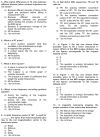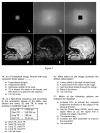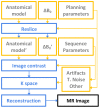Magnetic Resonance Simulation in Education: Quantitative Evaluation of an Actual Classroom Experience
- PMID: 34577231
- PMCID: PMC8468339
- DOI: 10.3390/s21186011
Magnetic Resonance Simulation in Education: Quantitative Evaluation of an Actual Classroom Experience
Abstract
Magnetic resonance is an imaging modality that implies a high complexity for radiographers. Despite some simulators having been developed for training purposes, we are not aware of any attempt to quantitatively measure their educational performance. The present study gives an answer to the question: Does an MRI simulator built on specific functional and non-functional requirements help radiographers learn MRI theoretical and practical concepts better than traditional educational method based on lectures? Our study was carried out in a single day by a total of 60 students of a main hospital in Madrid, Spain. The experiment followed a randomized pre-test post-test design with a control group that used a traditional educational method, and an experimental group that used our simulator. Knowledge level was assessed by means of an instrument with evidence of validity in its format and content, while its reliability was analyzed after the experiment. Statistical differences between both groups were measured. Significant statistical differences were found in favor of the participants who used the simulator for both the post-test score and the gain (difference between post-test and pre-test scores). The effect size turned out to be significant as well. In this work we evaluated a magnetic resonance simulation paradigm as a tool to help in the training of radiographers. The study shows that a simulator built on specific design requirements is a valuable complement to traditional education procedures, backed up with significant quantitative results.
Keywords: MRI; magnetic resonance imaging; medical training/educational tool; radiographer training; simulator system.
Conflict of interest statement
This MR simulator has been carried out at the University of Valladolid and has been partially funded by the company Giveme5D, Valladolid, Spain. A technology transfer agreement has been signed by both parties. The second author is the main shareholder of this company; he has provided radiological guidance throughout the simulator design process.
Figures








Similar articles
-
Integration of an intelligent tutoring system in a magnetic resonance simulator for education: Technical feasibility and user experience.Comput Methods Programs Biomed. 2020 Oct;195:105634. doi: 10.1016/j.cmpb.2020.105634. Epub 2020 Jun 30. Comput Methods Programs Biomed. 2020. PMID: 32645627
-
A Comparison of Robotic Simulation Performance on Basic Virtual Reality Skills: Simulator Subjective Versus Objective Assessment Tools.J Minim Invasive Gynecol. 2017 Nov-Dec;24(7):1184-1189. doi: 10.1016/j.jmig.2017.07.019. Epub 2017 Jul 27. J Minim Invasive Gynecol. 2017. PMID: 28757439 Clinical Trial.
-
Blinded randomized controlled study of a web-based otoscopy simulator in undergraduate medical education.Laryngoscope. 2017 Jun;127(6):1306-1311. doi: 10.1002/lary.26246. Epub 2016 Aug 31. Laryngoscope. 2017. PMID: 27577536 Clinical Trial.
-
Utility of Modern Arthroscopic Simulator Training Models: A Meta-analysis and Updated Systematic Review.Arthroscopy. 2018 May;34(5):1650-1677. doi: 10.1016/j.arthro.2017.10.048. Epub 2018 Jan 20. Arthroscopy. 2018. PMID: 29366742
-
Take-Home Training in Laparoscopy.Dan Med J. 2017 Apr;64(4):B5335. Dan Med J. 2017. PMID: 28385174 Review.
Cited by
-
KomaMRI.jl: An open-source framework for general MRI simulations with GPU acceleration.Magn Reson Med. 2023 Jul;90(1):329-342. doi: 10.1002/mrm.29635. Epub 2023 Mar 6. Magn Reson Med. 2023. PMID: 36877139 Free PMC article.
References
-
- McKagan S., Perkins K.K., Dubson M., Malley C., Reid S., LeMaster R., Wieman C. Developing and researching PhET simulations for teaching quantum mechanics. Am. J. Phys. 2008;76:406–417. doi: 10.1119/1.2885199. - DOI
MeSH terms
LinkOut - more resources
Full Text Sources

